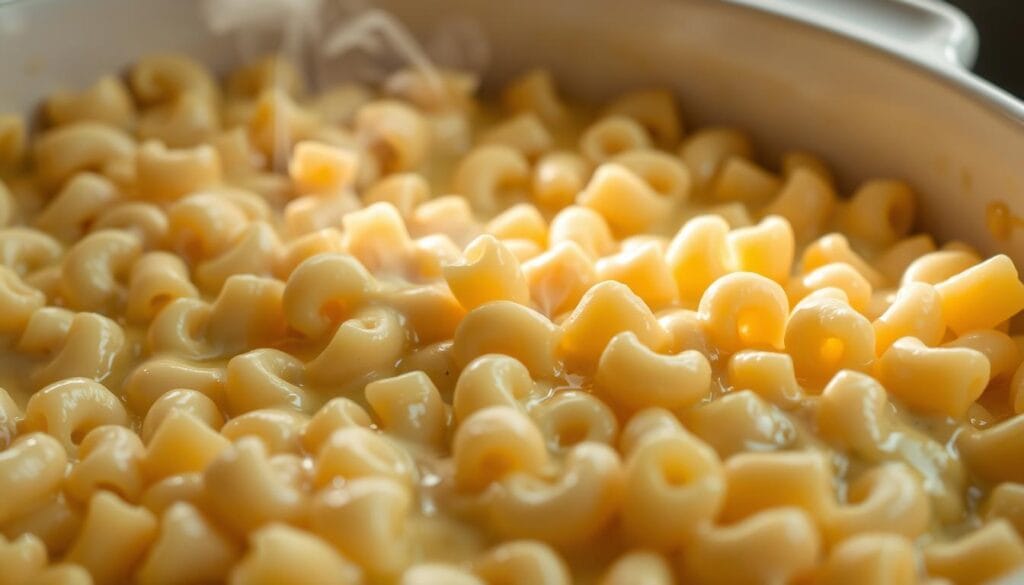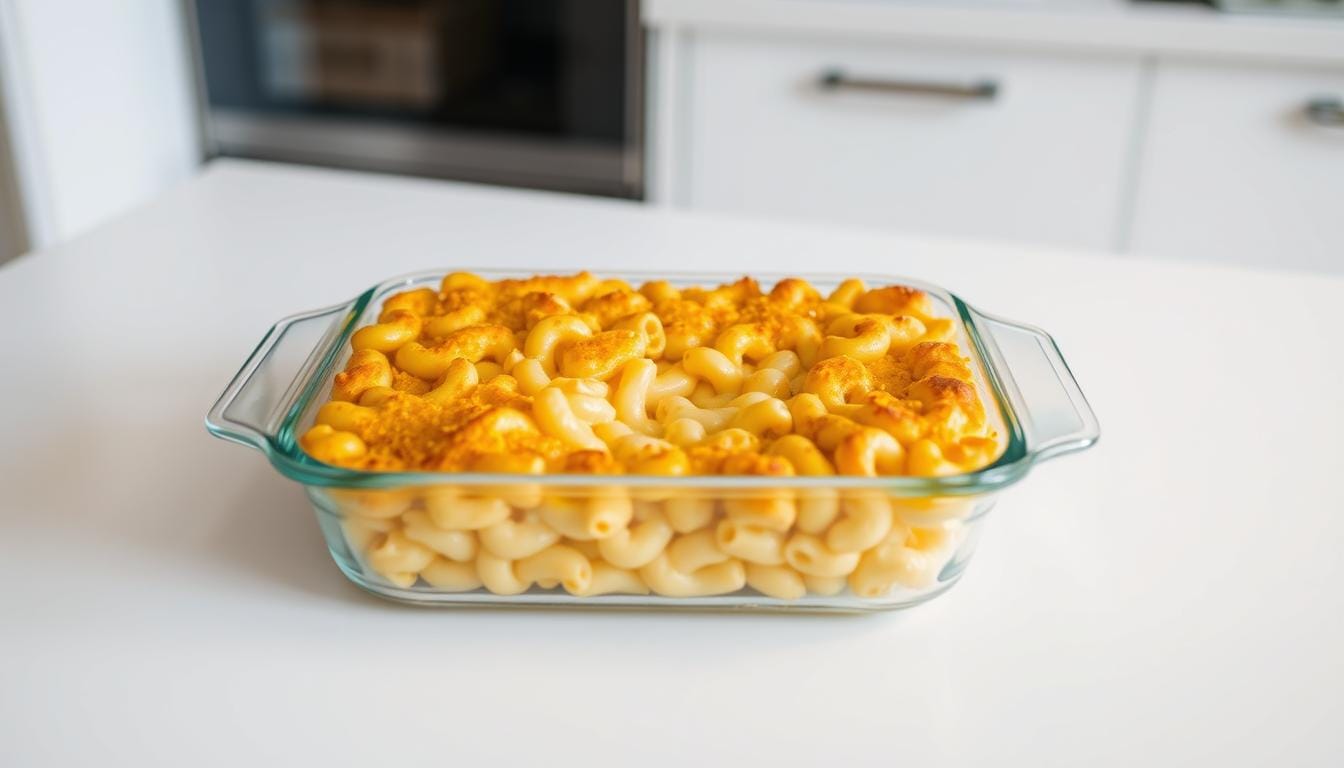Macaroni and cheese is more than just a meal; it’s a comfort. It’s a staple at family gatherings and late-night snacks. But what if you could enjoy it whenever you want? Learning to freeze macaroni and cheese is a big help. It lets you prep meals ahead of time and keeps the dish delicious.
Freezing macaroni and cheese means you can have a tasty, satisfying meal any night. It’s perfect for busy evenings when you need something quick but delicious.
Key Takeaways
- Freezing macaroni and cheese is a great way to meal prep and save time.
- Preserving texture and taste is essential when freezing this creamy dish.
- Learning how to freeze macaroni and cheese can reduce waste and save money.
- You can successfully freeze both cooked and uncooked versions.
- Utilizing proper storage techniques prevents freezer burn.
Introduction to Freezing Macaroni and Cheese
Freezing mac and cheese is a smart way to plan meals. It lets you enjoy this favorite dish whenever you want. It’s perfect for quick family dinners or when guests drop by unexpectedly.
Macaroni and cheese is great for any event. Freezing it means you always have a tasty meal ready. It saves time and keeps leftovers fresh.
Having frozen mac and cheese is a big help on busy nights. Just thaw and reheat for a meal that everyone loves. Freezing macaroni and cheese makes weeknights easier.
Understanding the Freezing Process for Macaroni and Cheese
The freezing process for macaroni and cheese uses key techniques to keep it tasty and smooth. First, let your macaroni and cheese cool down completely at room temperature. This is important because hot food can make the freezer too cold, causing frost and uneven freezing.
After cooling, divide the macaroni and cheese into smaller portions. This makes thawing easier and helps you only thaw what you need. Use airtight containers or heavy-duty freezer bags to prevent freezer burn. This keeps the flavor and texture of your dish intact.
To improve freezing, wrap each portion tightly with plastic wrap before putting it in a container. This step is vital as it reduces air exposure, helping to preserve quality. Then, mark each package with the freezing date to track freshness.
By following these freezing techniques, you can enjoy your macaroni and cheese later without losing its taste or texture. The right freezing process can make your macaroni and cheese last longer while keeping it delicious for future meals.
Can You Freeze Macaroni and Cheese?
You can freeze macaroni and cheese, whether it’s cooked or uncooked. This makes it easy to save time on busy weeknights or plan meals ahead. Knowing the difference between cooked and uncooked freezing helps you choose what works best for you.
Yes, You Can Freeze Both Cooked and Uncooked Versions
Freezing cooked macaroni and cheese is convenient, but the texture changes. The pasta gets softer when reheated. Freezing uncooked macaroni and cheese keeps more of its original texture, which is important to consider.
Understanding Texture Changes After Freezing
Freezing cooked macaroni and cheese means you’ll notice texture changes. The pasta becomes softer after freezing and reheating. To avoid this, try baking your macaroni and cheese before freezing. This helps keep the texture firmer, making it more enjoyable to reheat.
Best Practices for Freezing Homemade Mac and Cheese
Freezing macaroni and cheese needs careful steps to keep it tasty and smooth. You must cool your dish right and pick the right containers for storage.
Cooling Your Mac and Cheese Before Freezing
Let your mac and cheese cool down to room temperature before freezing. This step stops condensation, which can ruin the dish’s quality. To cool it faster, spread it thinly in a baking dish. Stir it now and then to cool evenly.
Choosing Containers for Freezing
Picking the right freezer containers is key to keeping your mac and cheese fresh. Choose airtight containers or heavy-duty zip bags made for the freezer. Make sure to leave some space at the top for expansion. With the right seal, your mac and cheese can stay good for up to three months.
| Container Type | Usage Tips | Duration of Storage |
|---|---|---|
| Airtight Containers | Ensure a tight seal to prevent freezer burn. | Up to 3 months |
| Heavy-Duty Zip Bags | Remove as much air as possible before sealing. | Up to 3 months |
| Aluminum Foil | Wrap tightly around the mac and cheese for added protection. | Up to 2 months |

How to Properly Store Macaroni and Cheese in the Freezer
Storing macaroni and cheese in the freezer needs careful steps to keep it tasty. Knowing how to store it right can stop freezer burn. This means your meal stays delicious when you reheat it. We’ll talk about using plastic wrap and foil, and the perks of airtight containers and zip bags.
Using Plastic Wrap and Foil for Protection
Wrapping your macaroni and cheese with plastic wrap and foil keeps it safe from freezer burn. Plastic wrap sticks to the food, keeping air out. This stops it from getting worse. Then, adding foil on top gives more protection, keeping it warm.
Freezing in Airtight Containers or Zip Bags
Freezing macaroni and cheese in airtight containers or zip bags is also smart. These keep air out, lowering freezer burn risk. Containers are strong, stackable, and save space. Zip bags are easy to use for small portions. Just remember to label them so you can find what you need in the freezer.
| Storage Method | Pros | Cons |
|---|---|---|
| Plastic Wrap and Foil | Good air barrier, prevents freezer burn | Single-use, can be less eco-friendly |
| Airtight Containers | Reusable, stackable, organized | Requires space, can be bulky |
| Zip Bags | Space-saving, easy to label and store | Less sturdy, can tear |
Tips for Freezing Mac and Cheese Effectively
Freezing mac and cheese is a great way to enjoy it later. A few strategies can keep your dish tasty and appealing. Follow these tips to improve the quality and taste of your frozen mac and cheese.
Undercooking Pasta for Better Texture
When you’re making macaroni and cheese for freezing, try undercooking the pasta. Cooking it a bit less than the package says helps. This way, the pasta stays firm and absorbs the sauce better when you reheat it.
Freezer-Friendly Ingredient Choices
Choosing the right ingredients is key. Use freezer-friendly ingredients like creamy cheeses and sauces. Cheddar, mozzarella, and béchamel sauces freeze well and keep their flavor. Stay away from ingredients that might change texture when frozen.

Preserving Mac and Cheese in the Freezer for Long-Term Storage
Storing macaroni and cheese in the freezer right is key. It lets you enjoy your dish weeks later. Knowing how long it stays good is important for keeping it tasty.
How Long Can Mac and Cheese Last in the Freezer?
Macaroni and cheese can last up to three months in the freezer. After that, it might not taste as good. Always label your containers with the date to keep track.
Avoiding Freezer Burn and Maintaining Quality
Freezer burn can ruin your mac and cheese. Use airtight containers or heavy-duty bags to prevent it. This keeps the dish creamy and flavorful. Check your mac and cheese often and throw away any with freezer burn.
How to Thaw Frozen Macaroni and Cheese
Thawing frozen macaroni and cheese right is key to enjoying its creamy texture and rich flavor. You have a few options, each with its own time and quality impact. Choosing the best thawing method ensures your dish stays delicious and avoids any problems.
The Best Thawing Method: Refrigeration
The safest and most effective thawing method is refrigeration. Just move your dish from the freezer to the fridge the night before. This slow thaw keeps your mac and cheese’s texture and taste perfect.
Alternative Thawing Methods: Microwave and Countertop
If you’re in a hurry, you can use the microwave or countertop thawing. The microwave is quick, but be careful with the settings. Use the defrost option to prevent cooking parts of the dish. Countertop thawing is also possible, but watch out for bacteria growth if it stays in the danger zone too long. Always keep an eye on it to stay safe.

Reheating Frozen Mac and Cheese
Reheating mac and cheese can bring back its delicious flavor and texture. You can choose from several reheating methods to get great results. Learning these techniques will help you enjoy your frozen mac and cheese just like it was fresh.
Different Methods: Oven, Microwave, and Stovetop
There are a few ways to reheat frozen mac and cheese. You can use the oven, microwave, or stovetop. Each method has its own benefits:
- Oven: Preheat your oven to 350°F. Put the frozen mac and cheese in an oven-safe dish. Cover it with foil and heat for 25-30 minutes. This method ensures even heating and keeps the creamy texture.
- Microwave: Use a microwave-safe container for the mac and cheese. Heat in short bursts, about 2-3 minutes each, stirring in between. This method is quick but needs careful attention to avoid uneven warming.
- Stovetop: Heat the mac and cheese gently in a saucepan over low to medium heat. Stir often to prevent sticking and ensure even temperature. This method lets you control the heat better but requires more attention.
Restoring Creaminess During Reheating
One challenge with reheating mac and cheese is keeping it creamy. Adding a splash of milk or cream can help. Use about a tablespoon per serving, adjusting as needed. Stir well to mix in the liquid and make your mac and cheese creamy again.
Conclusion
Learning how to freeze macaroni and cheese makes meal prep easier and tastier. By following the right steps, your mac and cheese will stay creamy and flavorful. It’s key to cool it down well and use the right containers to avoid freezer burn.
This guide highlights the most important tips for keeping your mac and cheese fresh. Choose the right ingredients, cool it properly, and reheat it well. With these steps, you can enjoy mac and cheese any time, no matter your schedule.
Now you know how to freeze and store your favorite comfort food. It’s time to put these tips into action. Enjoy having your homemade mac and cheese ready when you need a warm, satisfying meal!

